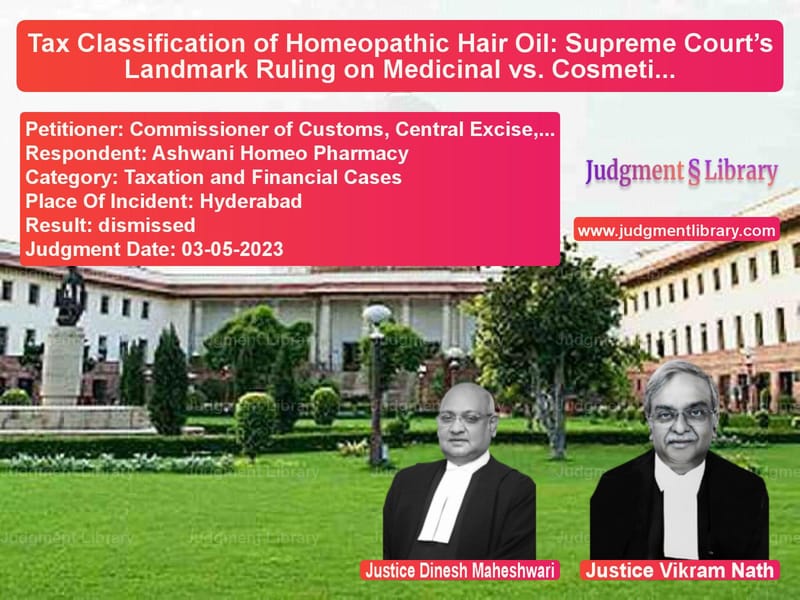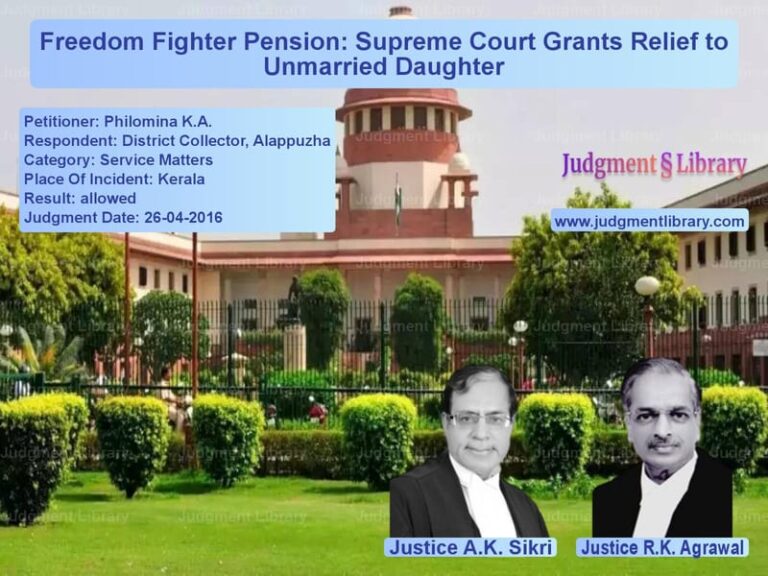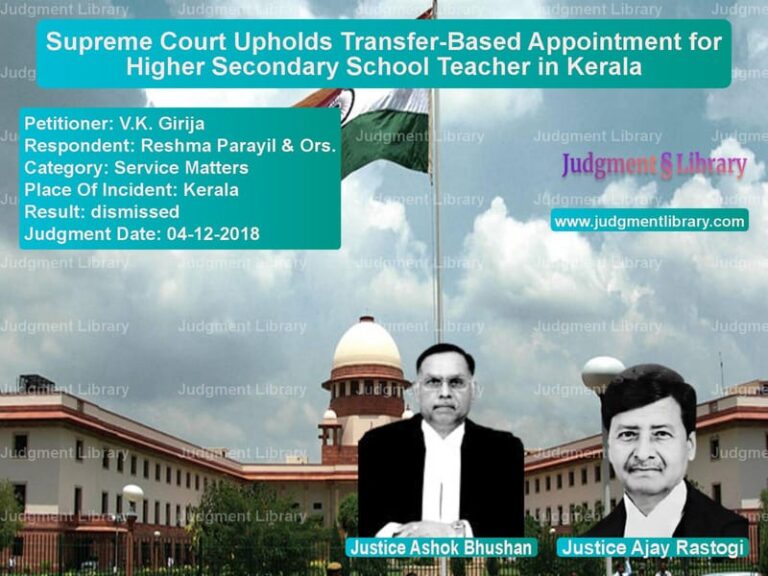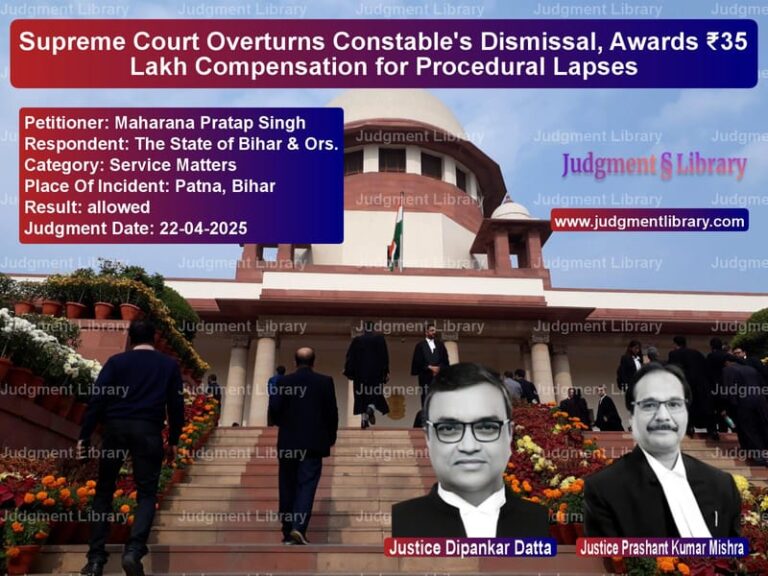Tax Classification of Homeopathic Hair Oil: Supreme Court’s Landmark Ruling on Medicinal vs. Cosmetic Products
The Supreme Court of India, in the case of Commissioner of Customs, Central Excise, and Service Tax, Hyderabad vs. Ashwani Homeo Pharmacy, addressed a long-standing dispute regarding the tax classification of ‘Aswini Homeo Arnica Hair Oil’ (AHAHO). The key question before the Court was whether the product should be classified as a ‘medicament’ under Chapter 30 of the Central Excise Tariff Act, 1985, or as a ‘cosmetic’ under Chapter 33, which carries a higher excise duty. The ruling provided much-needed clarity on the criteria for differentiating between medicinal and cosmetic products under Indian tax laws.
Background of the Case
The dispute dates back to 1994, when Aswini Homeo Pharmacy’s product, AHAHO, was classified under Chapter 30 as a medicament. The product contains homeopathic medicinal ingredients, including Arnica Montana, Cantharis, Pilocarpine, and Cinchona, which are recognized for their therapeutic properties. AHAHO was marketed as a treatment for dandruff, hair fall, and other scalp-related conditions.
However, in 2012, after amendments to the excise tariff classification, tax authorities reclassified the product under Chapter 33 as a cosmetic, arguing that it was primarily used for hair care rather than medicinal treatment. This reclassification led to a significant increase in excise duty, prompting Ashwani Homeo Pharmacy to challenge the decision.
Read also: https://judgmentlibrary.com/supreme-court-orders-fresh-decision-in-income-tax-settlement-case/
Legal Issues Considered
The Supreme Court examined several key issues, including:
- Whether AHAHO should be classified as a medicament or a cosmetic under the Central Excise Tariff Act.
- The relevance of past classification decisions and their impact on the current tax dispute.
- The importance of the ‘common parlance test’ and the ‘ingredient test’ in determining product classification.
- The significance of a product’s marketing and labeling in tax classification.
- Whether the amendments made in 2012 warranted a change in classification.
Arguments by the Petitioner (Tax Authorities)
The Commissioner of Customs, Central Excise, and Service Tax, Hyderabad, made the following arguments:
- Although AHAHO contained medicinal ingredients, it was primarily used for hair care, making it a cosmetic rather than a medicament.
- The product was widely available in general stores and was not exclusively sold in pharmacies, suggesting that consumers purchased it for cosmetic purposes.
- The label of AHAHO did not require a mandatory prescription from a doctor, which is a characteristic of medicinal products.
- Following the 2012 amendments, the excise classification for similar products had changed, necessitating a reassessment of AHAHO’s classification.
- The product’s marketing and branding emphasized hair growth and shine rather than therapeutic treatment, further supporting its classification as a cosmetic.
Arguments by the Respondent (Ashwani Homeo Pharmacy)
Ashwani Homeo Pharmacy defended the classification of AHAHO as a medicament under Chapter 30, making the following counterarguments:
- AHAHO had been classified as a medicament since 1994, and there was no justification for changing its classification.
- The product contained homeopathic medicinal ingredients recognized for their therapeutic effects on hair and scalp health.
- AHAHO was manufactured under a valid homeopathic drug license and complied with the Drugs and Cosmetics Act, 1940.
- The presence of medicinal components distinguished it from regular hair oils, making it ineligible for classification as a cosmetic.
- Several past judicial and administrative decisions had upheld the classification of similar products as medicaments.
- The 2012 amendments did not fundamentally alter the nature of the product, and the authorities had misapplied the changes to reclassify AHAHO arbitrarily.
Supreme Court’s Observations
Application of the ‘Common Parlance Test’
The Court reiterated the importance of the ‘common parlance test’ in tax classification. It emphasized that a product should be classified based on how it is commonly understood by consumers. In this case, the Court found that:
- AHAHO was widely recognized as a homeopathic remedy rather than a mere cosmetic product.
- Consumers purchased the product for its therapeutic properties rather than solely for hair grooming.
- Although the product was available in general stores, it was also stocked in pharmacies, reinforcing its status as a medicinal product.
Evaluation Under the ‘Ingredient Test’
The Court also applied the ‘ingredient test,’ which assesses whether the active components of a product are medicinal in nature. The Court noted that AHAHO contained ingredients commonly used in homeopathic treatments, including:
- Arnica Montana: Used in homeopathy for hair growth and scalp treatment.
- Cantharis: Recognized for treating scalp inflammation and hair fall.
- Pilocarpine: Used to stimulate hair follicles and treat alopecia.
- Cinchona: Prescribed in homeopathy for various scalp disorders.
Based on these findings, the Court ruled that the product met the definition of a medicament under Chapter 30.
Significance of Drug Licensing
The Court further observed that AHAHO was manufactured under a valid homeopathic drug license. It referenced previous rulings where products with medicinal ingredients and drug licenses had been classified as medicaments.
Impact of the 2012 Amendments
The Court found that the 2012 amendments did not change the fundamental nature of the product. The amendments were intended to clarify classification guidelines but did not mandate the reclassification of existing medicaments as cosmetics.
Final Judgment
The Supreme Court ruled in favor of Ashwani Homeo Pharmacy, stating that:
- AHAHO qualified as a medicament under Chapter 30 of the Central Excise Tariff Act, 1985.
- The 2012 amendments did not justify the reclassification of the product as a cosmetic.
- The excise duty demands and penalties imposed by the authorities were set aside.
- The classification of AHAHO as a medicament remained unchanged.
Key Takeaways
- Importance of Product Classification: The ruling reinforces that the classification of a product for tax purposes must consider its ingredients, purpose, and consumer perception.
- Judicial Precedents Matter: Past decisions that classify similar products as medicaments play a crucial role in tax disputes.
- Medicinal Ingredients Influence Classification: If a product contains recognized medicinal ingredients and is manufactured under a drug license, it is more likely to be classified as a medicament.
- Regulatory Changes Do Not Automatically Alter Classification: The Court clarified that amendments to tax regulations must be applied correctly and should not lead to arbitrary reclassifications.
Conclusion
The Supreme Court’s decision in this case sets a precedent for future tax classification disputes involving medicinal and cosmetic products. By upholding the classification of AHAHO as a medicament, the Court has provided much-needed clarity on how homeopathic and therapeutic products should be assessed under tax laws.
Petitioner Name: Commissioner of Customs, Central Excise, and Service Tax, Hyderabad.Respondent Name: Ashwani Homeo Pharmacy.Judgment By: Justice Dinesh Maheshwari, Justice Vikram Nath.Place Of Incident: Hyderabad.Judgment Date: 03-05-2023.
Don’t miss out on the full details! Download the complete judgment in PDF format below and gain valuable insights instantly!
Download Judgment: commissioner-of-cust-vs-ashwani-homeo-pharma-supreme-court-of-india-judgment-dated-03-05-2023.pdf
Directly Download Judgment: Directly download this Judgment
See all petitions in Customs and Excise
See all petitions in Tax Evasion Cases
See all petitions in Income Tax Disputes
See all petitions in Banking Regulations
See all petitions in Tax Refund Disputes
See all petitions in Judgment by Dinesh Maheshwari
See all petitions in Judgment by Vikram Nath
See all petitions in dismissed
See all petitions in supreme court of India judgments May 2023
See all petitions in 2023 judgments
See all posts in Taxation and Financial Cases Category
See all allowed petitions in Taxation and Financial Cases Category
See all Dismissed petitions in Taxation and Financial Cases Category
See all partially allowed petitions in Taxation and Financial Cases Category







